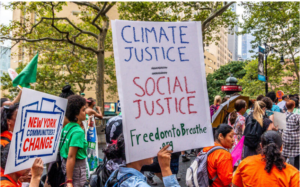
A Celebration of Conservation
05/23/2023
Revolutionizing Public Services
01/16/2024In the grand tapestry of conservation, the vibrant threads of Diversity, Equity, Inclusion, and Justice (DEIJ) are crucial yet often underrepresented. True commitment to DEIJ in conservation funding isn’t just about surface-level nods or token gestures; it’s about embedding these principles deeply and sincerely into the very fabric of conservation efforts. This means looking beyond the facade of diversity to ensure that every dollar spent genuinely contributes to equitable and just conservation practices. This means that it’s time we transition from performative gestures to substantial, impactful actions.
For example, imagine a conservation project that not only protects a forest but also empowers the indigenous community living there, recognizing their ancestral knowledge and rights. This is the kind of DEIJ-driven initiative we need to fund—projects that respect and uplift all voices, especially those that have been historically marginalized.
The Illusion of Inclusion: Looking Beyond the Surface
Having a single DEIJ role might look good on paper, but it barely scratches the surface of what true inclusion entails. It’s not about collecting accolades for diversity; it’s about dismantling the systemic barriers that have long sidelined underrepresented voices in conservation. This requires more than a superficial nod toward inclusion; it demands a thorough reevaluation of where and how funds are allocated.
It’s easy to fall into the trap of thinking we’re doing enough by having a diverse team on paper. But let’s be real: True inclusion is about tearing down the systemic barriers that have long kept underrepresented voices on the sidelines. It’s about doing the hard work to ensure that everyone has a fair shot, not just giving a cursory nod to the idea of diversity.
This is why we should consider the impact of involving local communities in conservation planning from the get-go, ensuring their needs and insights shape the project. This level of inclusion enriches conservation efforts, making them more effective and sustainable in the long run.
Investing in Impact: The Power of Purposeful Funding
True integration of DEIJ in conservation means aligning every dollar with the principles of equity and justice. It’s not just about funding projects; it’s about investing in impact—an impact that resonates with and uplifts marginalized communities, ensuring they’re not just participants but leaders in conservation efforts. This kind of funding goes beyond traditional metrics, focusing on long-term, sustainable change that elevates the role of diversity in driving environmental solutions.
Every time DEIJ and conservation are mentioned the conversation should always be steered toward how can we ensure that every dollar spent, furthers the cause of equity and justice. Because this isn’t just about funding any project that comes our way; it’s about strategic investment in initiatives that make a real difference, particularly for marginalized communities. This means looking beyond short-term gains to the broader, lasting impact that embodies true diversity and inclusion.
For instance, imagine funding projects that not only conserve biodiversity but also provide sustainable livelihoods for local communities, or that provide pipelines to careers in the sciences, thereby addressing social inequities. This kind of holistic approach exemplifies the impactful funding we need to champion.

The Call for Action: Moving Beyond Lip Service
The conservation community must move beyond lip service to real action. This means rethinking funding strategies to prioritize initiatives that are not only environmentally sound but also socially equitable. It’s a call to funders at all levels to recognize the multifaceted value of DEIJ-centered projects and to commit the necessary resources to bring these initiatives to life.
Imagine, a call to action that could involve creating more inclusive grant programs, which specifically target grassroots initiatives led by marginalized groups, ensuring these vital projects receive the support they need to flourish.
Conclusion: A New Era of Conservation Funding
Embracing DEIJ in conservation funding isn’t just the right thing to do; it’s the smart thing to do. It’s about recognizing that true conservation success hinges on our ability to foster an inclusive, equitable, and just environmental movement. As we pivot towards this new era, the measure of our commitment will be reflected not just in our words, but in our actions and investments. Let’s ensure our efforts in conservation are as diverse and vibrant as the ecosystems we strive to protect.
In the end, if we are to see real change in conservation, our society must commit to making conservation as richly diverse and inclusive as the ecosystems we’re fighting to protect, ensuring that our efforts reflect the complex, interconnected world we live in.

